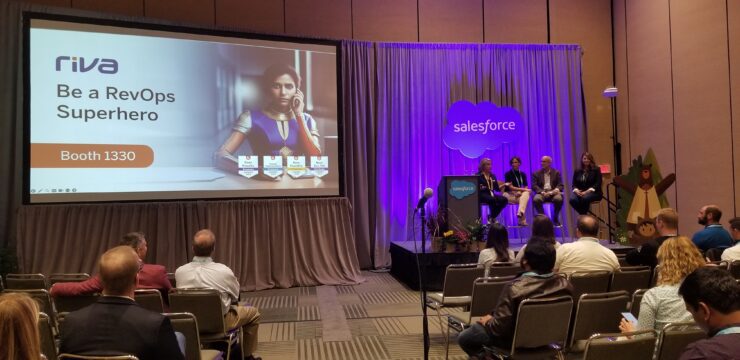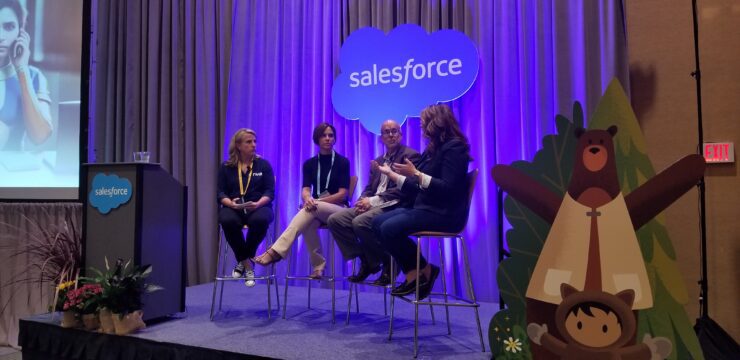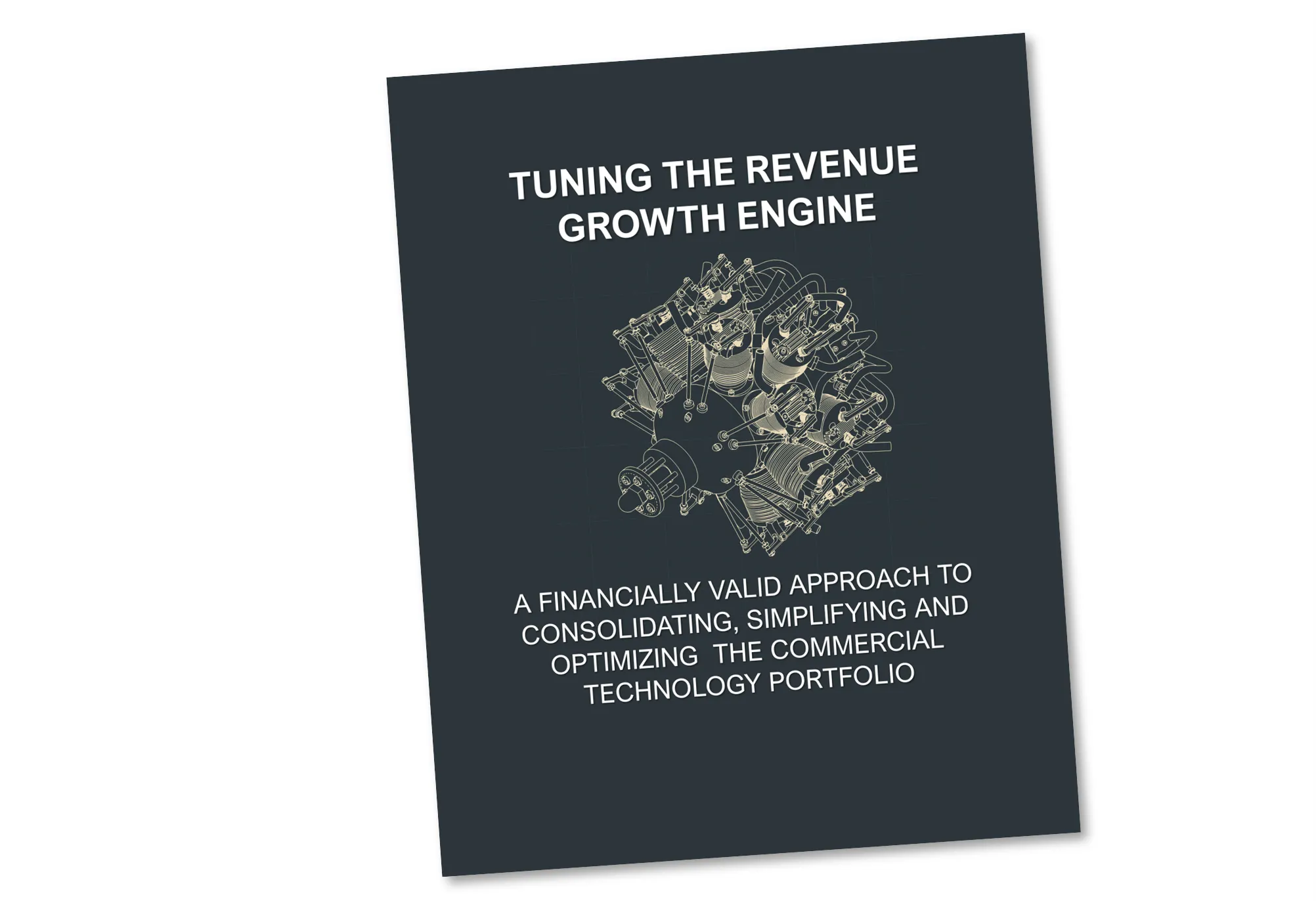At Dreamforce 2023 Riva hosted a panel entitled “Enterprise Rev Ops: Challenges & Data Needs in an AI world.” The panel featured three guests whose experience with revenue operations make them uniquely qualified to provide insights on the evolving state of Revenue Operations, and who shared a wealth of information during the panel discussion:
- Tina Cartwright, SVP and Chief Sales, Credit and Servicing Center of Excellence Leader at US Bank
- Stephen Diorio, Managing Director of the Revenue Enablement Institute and Wharton Fellow
- Michelle Feinstein, GM/VP of Wealth and Asset Management at Salesforce

Below is a summary of the key takeaways from the panel discussion.
- The definition of Revenue Operations (“RevOps”) is evolving
- The concept of a “Single Source of Truth” is still relevant—and important
- As corporations place greater emphasis on customer experience as a primary driver of success, trust becomes increasingly important
- Data only matters if customer-facing teams trust it, access it, and is easy to use
- AI can help to scale data access and use, fuel automation, enhance efficiency, boost productivity, and personalize customer experience—but it’s dependent on good data and processes, and the right people
- The rapid evolution of revenue operations is bringing dramatic structural changes to overcome the challenges of longstanding operational siloed hierarchies
- Enterprise executives believe RevOps process and data integration are important—even in cases where their understanding of its role is evolving
1. The definition of Revenue Operations (“RevOps”) is evolving
Enterprises have long gathered large volumes of customer data. As the awareness of the value of that data grows, companies are embracing revenue operations as the means to unify, govern, and share data with customer-facing teams that need it to understand and build and guide customer journeys and relationships, optimize customer experiences and engagement, grow customer lifetime value, and reduce customer churn.
As awareness of the importance of revenue operations grows, its definition continues to evolve. According to Stephen Diorio from the Revenue Enablement Institute, “It’s the alignment of revenue teams—and the operations, systems, data, and processes that support them—along the entire revenue cycle to generate more sustainable and scalable growth. It’s different in every organization. It’s like a fingerprint. How we marshall cross-functional operations teams—some organizations have it spread out over 40-50 organizations and dozens of instances of Salesforce—is critical. The team that connects the most dots wins.”
Michelle Feinstein, from Salesforce, agrees with this perspective and refines the definition as it applies to financial services. “You’re trying to reduce complexity. You’re trying to drive profitable growth. You’re trying to become data-driven as an organization. I think about wealth management firms and their line of business (LOB) structures like living in an apartment in New York City. Every LOB and department lives in its own apartment, no one invites you to have dinner, no one shares anything, and you’re trying to break that model.”
Tina Cartwright offered her firsthand experience on revenue operations with RevOps at U.S. Bank. “We call [the head of RevOps] the Product Officer. For us, it’s about having a responsibility within the organization to connect the business strategy with the revenue-generating organizations with all those enabling functions—our data, our technology, our digital teams, and the operations team all having a focal point to connect that prioritization and start thinking about the entire lifecycle, not just the individual siloed business functions. The Product Officer role is the bridge for us to start thinking very differently and organizing around that holistic customer journey.”
2. The concept of a “Single Source of Truth” is still relevant—and important
Revenue operations offer the promise of breaking down departmental, technological, and operational silos to bring customer data together, connect cross-functional teams, consolidate customer journeys, and leverage the full potential of each customer engagement. CRM systems are often seen as the leading candidate as the single source of truth companies seek. But in enterprises where there are multiple instances of CRM and multiple systems managing the data, the challenge is ongoing.
Michelle Feinstein articulates that challenge—and the reward of navigating the data unification process effectively. “There’s a lot of data that advisors aren’t capturing when they’re facing off with new client types. How do we convince advisors to actually start capturing the data? How do we make it as easy as possible? It’s about showing the value of the output and the result. It can be a little painful up front, but you start capturing the right types of data, you can power new products and services, cross-sell opportunities, and better service customer experiences.”
According to Stephen Diorio, “There are thousands of smart things you can do. What’s important is what you do first. Choosing a RevOps solution like Riva to connect Outlook to Salesforce ensures that the data remains clean and that every conversation with a customer is going to be reflected. The customer engagement data you collect is probably the largest financial asset in the business. The customer data of American Airlines is more valuable than the entire company—including the planes. In B2B, what sits in the middle?”
Tina Cartwright picks up that thread with her experience at U.S. Bank, “For us, RevOps has been about transparency and understanding the users’ behaviors. [Customer-facing teams] were doing things inconsistently, but now they’re working from a solid foundation.”
3. As corporations place greater emphasis on customer experience as a primary driver of success, trust becomes increasingly important
The philosophical shift in corporate focus from shareholder to customer value has put trust in the spotlight. And while it may seem like a no-brainer, earning customer trust requires enormous and continued dedication and can be lost in a single unsatisfactory outcome—particularly in industries like financial services and other regulated industries.
“Trusted enterprises have become a top priority for customers. As customers navigate a rapidly shifting world, uncertainty, fear, questions of trust, values, and integrity occupy their minds,” says Michelle Feinstein. “They want brands to prove that they can be trusted—and 88% of customers believe trust becomes more important in times of change.”
How best to earn that trust? It all comes down to client knowledge—an area where revenue operations ability to unify customer data is mission-critical. “To build trust, a firm must know their clients’ needs, wants, goals, and fears, and then personalize experiences,” Michelle Feinstein says. “They need to offer relevant products and solutions that appeal to the needs of different segments and meet them where they want to be met. They must respond to issues in real-time and deliver transparency and service excellence with flexible segmentation on channels of choice.”

4. Data only matters if customer-facing teams trust it—and use it
In order for customers to trust your enterprise, your customer-facing teams need to trust the data they rely on. In enterprises where customer data is siloed, and comprehensive, accurate customer histories are unavailable, revenue operations ability to unify and govern customer journey data—and to ramp up the consistency of its quality—can have a transformative effect.
But achieving that kind of systemic transformation and winning the trust customer-facing teams need to adopt revenue operations-enhanced CRM takes time and effort. Speaking from experience, U.S. Bank’s Tina Cartwright offered her recommendations on how to build a culture of customer data trust among customer-facing teams:
- “When you’re building a new experience, you need to bring the end-users into the process
- “Explain the why: why are we doing this?
- “Incorporate end-users in the development of the initiative—and demonstrate why the data inputs they make are important to their success
- “Make change incremental—not all at once. People are more likely to adopt changes they can appreciate and embrace. Big changes can be overwhelming, and can hinder adoption
- “When you ask for and get feedback on whatever revenue operations solutions you build, take them seriously—and act on them”
5. AI can help to scale data access and use, fuel automation, enhance efficiency, boost productivity, and personalize customer experience—but it’s dependent on good data and processes and the right people
Even though business intelligence has played a role in corporate strategies for more than a decade, the current pace of AI implementation seems meteoric. But like most technologies, AI implementation shouldn’t simply be a matter of plug-and-play. Its game-changing potential requires careful analysis and strategy to succeed. “Wealth management firms and advisors have a great opportunity to leverage AI to scale data and productivity, drive automation and efficiency, and finally deliver highly personalized experiences to clients,” says Michelle Feinstein. “Choosing the right platform to enable great experiences is a make-it-or-break-it decision.”
Scott Diorio echoes those sentiments, counseling enterprise leaders against throwing caution to the wind. “The reality is almost any sales and marketing task is impacted and enhanced by AI. Things get pretty sexy. But I advise you to start with the practical and the simple. That’s where the money [and the adoption] is in the short and medium term.” Diorio then goes further, offering a few practical examples of how enterprises can dip their toes in AI before plunging into the deep end, suggesting technologies that:
- “Simplify the seller experience, simplify the recording, cleaning and sharing of data, eliminate low value drudgery, and simplify the customer experience or what we call “People Facing AI”
- “Make sure customer interaction information is written back and attached to a customer profile so it can be leveraged.”
- “Run more scenarios and gaming options. The sales planning, channel design, budget and resource allocation is really just varying combinations of a dozen inter-related values. By jiggering those variables you can create a system that is twice as cost effective, profitable or fast growing as the one you have. The problem is there are millions of combinations and scenarios to try. Humans can’t do it, but AI can. That is a real benefit.”
And while it’s easy to focus on the technological wonder of AI, panel members agreed on the essential role people play in its successful, effective implementation. According to Michelle Feinstein, “I see wealth firms are hiring Chief Data Officers, Chief Revenue Officers, Chief Client Experience Officers, Experts in Integration/APIs, and now experts in AI and Large Language Modeling, and Heads of Advisor Experience to accelerate their ability to execute and meet market demand.”
The new titles and new responsibilities serve to highlight the rapid shift toward focus on improving customer experience—where an AI-enhanced view of customer data allows enterprises to move more nimbly and effectively in addressing customer needs than older, more siloed corporate hierarchies. Feinstein sees clear evidence that the shift is already underway. “Wealth firms are starting to prioritize AI use cases around advisor productivity, process automation, predictive modeling, content creation, behavioral and anomaly detection vs historical patterns, leveraging AI as a virtual assistant for Advisors and Service teams.”
6. The rapid evolution of revenue operations is bringing dramatic structural changes to longstanding operational hierarchies
Enterprises companies have long operated with very traditional departmental definitions—marketing, sales, operations, finance, and other departments tend to operate independently, engaging in collaboration as necessary to pursue shared objectives. The trouble, of course, is that those distinctions have created functional and technological silos that further isolate customer data—making it more difficult for customer-facing teams to access consolidated, comprehensive customer journey data. Revenue operations are beginning to alter that traditional perspective by consolidating customer data and transcending hierarchy to present a holistic view of 360⁰ customer data—enabling the transparency and cross-departmental collaboration necessary to accelerate the pursuit of shared objectives.
Michelle Feinstein expands on that idea: “Many firms I engage with have started to realign the way they run the business to more a RevOps model. They are breaking down team and data silos and bringing together business leaders across marketing and sales teams, data management teams, technology teams, customer success and service teams, and even finance to align on strategy, priorities, growth targets, and goals and success metrics.”
“From a job function perspective, it’s the fastest growing job in the US, but nobody defines it the same,” says Stephen Diorio. “Think about it as the consolidation of the different operations that support the revenue cycle. At the front of the revenue cycle, in marketing, its marketing operations, and to some degree customer analytics—folks who have control over first-party data and what we call the “owned channels”. Sales enablement, engineering, operations, training and development, and CRM administrators—where the account structure and system of record lives. And towards the end of the journey you are seeing customer success and experience and service operations being folded in—as more and more post-booking data and interactions become a bigger part of the revenue equation.”
7. Enterprise executives believe RevOps is important—even in cases where their understanding of its role is evolving
Conceptually, the promise of revenue operations continues to win support among executives who have seen its potential in action—and those who recognize the critical need to tap customer data in their efforts to improve customer lifetime value, grow revenues, and compete.
“RevOps is an area where firms are still learning and exploring what it means. 86% of executives told Forrester that RevOps is important to meet goals but only 41% understand what it is,” says Michelle Feinstein. “The RevOps model helps to center everyone in the organization around the client, with a focus on new opportunities for profitable growth, cost savings, and reducing revenue leakage. It aligns teams to set priorities to become a more scalable and data-driven organization and leverage customer data to identify new growth areas to pursue.”
But while executives may see the promise of revenue operations, they still face the challenge of funding its implementation, says Stephen Diorio. “It’s hard to justify a tech investment [in RevOps], so you kind of have to put the CFO on the defensive. Play some offense. Tell them “I own the most valuable asset in the company. I can show you, with concrete assumptions, how this is going to drive the share price.” When you win with cash flow and share price, let them come back and challenge your assumptions.”
Recent Articles
- Guide to Einstein Activity Capture: All You Need to Know
- 2024 Bankers Summit: 5 Key Takeaways
- Financial Services: Mastering Customer 360 and Client Engagement for Increased Customer Lifetime Value
- Dreaming Big at Salesforce Education Summit San Diego 2024
- How to Build a Sales Cadence in 2024: Examples and Best Practices

